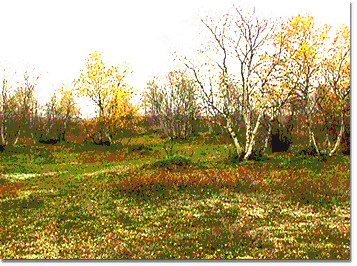

Pick out one of the subjects of ecology on the up there!
See also:
![]()

24 hours of sunlight during the summertime and the opposite during the wintertime! One of the characteristics of northerness is the lightness that continues almost the whole growing season and the night-day variation almost disappears. Many organisms of north have adapted to this: several animals are able to for example predate during night time. Many plant species are also able to assimilate during those light nights of mid-summer.. The radiation that continues through the night evens the 24 hours variation of temperature; the night frosts during the growing season are quite unusual. |

The essential character of the northern growing season is the almost constant daylight thus the disappearance of the normal day-night cycle. Many northern organisms have adapted to this: plants are able to photosynthetize all through the night in midsummer. Furthermore, the solar radiation through the night evens the temperature fluctuations; night frosts during the growth period are uncommon.
During the autumn at the end of August, the Lapland days are still longer than in southern Finland. This means that trees of southern origin do not get acclimated for winter in time and are in danger of freezing. Equally, a northern plant in a southern, late-summer, "dark" night thinks that the winter is near and starts acclimatising too early.
The strong annual light period is the most reliable of the northern ecological variables. It provides an exact signal to the biological clocks of the organisms. The light determines e.g. the phases of reproduction for many animals and the termination of the growing season for plants (the temperature fine-tunes it).
In spring there is an ecological conflict above the snow: there is enough light for photosynthesis already in March or April, but the cold nights prevent the acceleration of the vital functions (this applies to poikilothermic animals as well). When the vital functions finally do speed up, the wheels of life rapidly begin turning: the summer is short! Because coniferous forests are always relatively shaded, they lack the spring aspect of the deciduous southern woodlands.

Autumn colors are changing to the winter dark....
The leaves of mountain birches are dead, nearly all and the fine autumn colors on the graund are disappearing, too.

Carbon fixation of plants and the growth (and the reproduction) of organisms are limited here in the north also by the soil. The quantity of dying organic matter, like litter (dead leaves, flowers, fruits,buds, twigs etc.) as well as dead trees, root systems etc. is quite insignificant in the northern, sloowly growing forests, peat bogs and fjelds (see production of our forests!) Part of the dead matter is in circumstances where decomposers are not able to work very effectively, for example in mire peat.Anyhow, the fungal mycelia usually like to live in northern forest soil and they have a very important role for example in decomposing when bacteria and earthworms are absent. Moreover, many fungal mycelia live in symbiosis with most northern forest plants helping them to get nutrients from poor supplies. The well being of many northern forest plants is dependent on the well being of mycelia. In the north there are very few organisms that are able to fixate nitrogen. |
The shortage of available nitrogen is a typical feature of northern ecosystems and their function. The nitrogen gained through the decomposing process in Lapland forests is presumably only around 10 kilograms per hectare (a few kilograms of nitrogen is gained from the atmosphere). On the other hand, more abundant nitrogen availability might even be harmful considering e.g. wintering. Northern forest flora is composed mainly of species adapted to nutrient-poor soils; true coppices (=groves) and other fertile environments are very rare in Lapland, especially on dry soils.

(The left map above): The bedrock of Northern Finland is mainly
composed of ancient, nutrient-poor stones (granite, gneiss.
(The right map above): The fertile soil is ± rich in nutrients (and lime-rich) in very few areas.
The soil in the Northern Finland is generally either infertile podsol (in mineral soils) or infertile peat (in peat bogs).
The more fertile soils are found only in small areas - with more luxuriant vegetation (see the map right). On the soils with more nutrients the richness of vegetation is visible especially in the wet areas (mires etc.). Dry coppices (= groves) and suchlike are very rare in Lapland, but especially in the area of "Lapin kolmio" and in northern Kuusamo, rich fens and eutrophic pine fens are common. Unfortunately, a considerable part of them has already been drained. Nutrient-abundance may also be noticed in some aquatic environments (e.g. Stratiotes-lakes in Kittilä, see the classification of lakes!)..

(Above): a leaf of a sundew (Drosera longifolia) and a captured insects.
The majority of our mires are nutrient-poor, so the sundew acquires
nitrogen by capturing and "eating" small insects.

Sorry, section 'Lots of water' is not yet translated!
If You are interested to take a glance to Finnish version of this section,
please click these buttons:
Osat " Almost arctic light period", "Poor and cool soil" ja "Lots of water" end here!